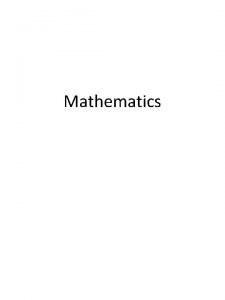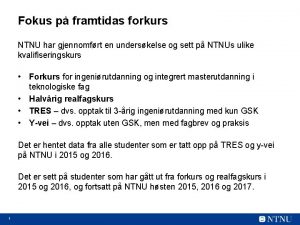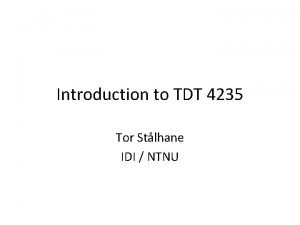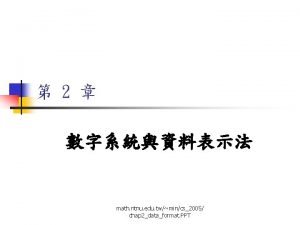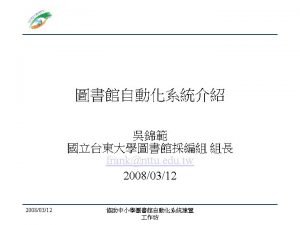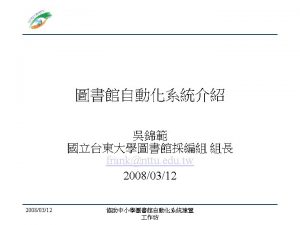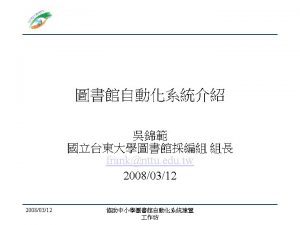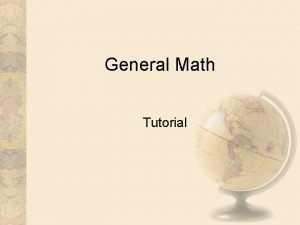hyfanntnu edu tw http math ntnu edu twhyfan

















![>> [mag angle] = polar_value(1) function [mag, angle] = polar_value(x, y) mag = %POLAR_VALUE >> [mag angle] = polar_value(1) function [mag, angle] = polar_value(x, y) mag = %POLAR_VALUE](https://slidetodoc.com/presentation_image_h2/b96ba04116cfce8b4446a763c7dfaa67/image-18.jpg)

















- Slides: 35

使用者定義函式 范洪源 hyfan@ntnu. edu. tw http: //math. ntnu. edu. tw/~hyfan 臺灣師範大學數學系



計算點(x 1, y 1)與點(x 2, y 2)的距離 function distance = dist 2(x 1, y 1, x 2, y 2) %DIST 2 Calculate the distance between two points 儲存之檔案名稱為 dist 2. m % Function DIST 2 calculates the distance between % two points (x 1, y 1) and (x 2, y 2) in a Cartesian % coordinate system. H 1 comment line % >> lookfor distance % Calling sequence: % distance = dist 2(x 1, y 1, x 2, y 2) DIST 2 Calculate the distance between two points % Define variables: % x 1 -- x-position of point 1 % y 1 -- y-position of point 1 % x 2 -- x-position of point 2 % y 2 -- y-position of point 2 % distance -- Distance between points >> help dist 2 DIST 2 Calculate the distance between two points Function DIST 2 calculates the distance between two points (x 1, y 1) and (x 2, y 2) in a Cartesian coordinate system. % Calculate distance. Calling sequence: distance = sqrt((x 2 -x 1). ^2 + (y 2 -y 1). ^2); distance = dist 2(x 1, y 1, x 2, y 2) end % function dist 2 使用者定義函式 T. -M. Hwang 4

呼叫 dist 2 % Get input data. disp('Calculate the distance between ax = input('Enter x value of point a: ay = input('Enter y value of point a: bx = input('Enter x value of point b: by = input('Enter y value of point b: two points: '); '); '); % Evaluate function result = dist 2 (ax, ay, bx, by); % Write out result. fprintf('The distance between points a and b is %fn', result); function distance = dist 2(x 1, y 1, x 2, y 2) 使用者定義函式 T. -M. Hwang 5





function out = sample(a, b) fprintf('In sample: a = %f, b = %f %fn', a, b); a = b(1) + 2*a; 輸入引數值改變 b = a. * b; out = a + b(1); fprintf('In sample: a = %f, b = %f %fn', a, b); a = 2; b = [6 4]; fprintf('Before sample: a = %f, b = %f %fn', a, b); out = sample(a, b); fprintf('After sample: a = %f, b = %f %fn', a, b); fprintf('After sample: out = %fn', out); >> test_sample Before sample: a = 2. 000000, b = 6. 000000 4. 000000 In sample: a = 10. 000000, b = 60. 000000 40. 000000 After sample: a = 2. 000000, b = 6. 000000 4. 000000 After sample: out = 70. 000000 使用者定義函式 T. -M. Hwang 10



function out = ssort(a) % Get the length of the array to sort nvals = size(a, 2); % Sort the input array for ii = 1: nvals-1 % Find the minimum value in a(ii) through a(n) iptr = ii; for jj = ii+1: nvals if a(jj) < a(iptr) iptr = jj; end % iptr now points to the minimum value, so swap a(iptr) % with a(ii) if ii ~= iptr temp = a(ii); a(ii) = a(iptr); a(iptr) = temp; end % Pass data back to caller out = a; 使用者定義函式 T. -M. Hwang 13

% Prompt for the number of values in the data set nvals = input('Enter number of values to sort: '); % Preallocate array = zeros(1, nvals); % Get input values for ii = 1: nvals % Prompt for next value string = ['Enter value ' int 2 str(ii) ': ']; array(ii) = input(string); >> test_ssort Enter number of values to sort: 6 Enter value 1: -5 Enter value 2: 4 Enter value 3: -2 Enter value 4: 3 Enter value 5: -2 Enter value 6: 0 End % Now sort the data sorted = ssort(array); % Display the sorted result. fprintf('n. Sorted data: n'); for ii = 1: nvals fprintf(' %8. 4 fn', sorted(ii)); end 使用者定義函式 Sorted data: -5. 0000 -2. 0000 0. 0000 3. 0000 4. 0000 T. -M. Hwang 14



![mag angle polarvalue1 function mag angle polarvaluex y mag POLARVALUE >> [mag angle] = polar_value(1) function [mag, angle] = polar_value(x, y) mag = %POLAR_VALUE](https://slidetodoc.com/presentation_image_h2/b96ba04116cfce8b4446a763c7dfaa67/image-18.jpg)
>> [mag angle] = polar_value(1) function [mag, angle] = polar_value(x, y) mag = %POLAR_VALUE Converts (x, y) to (r, theta) 1 >> [mag angle] = polar_value(0, 0) angle % Check for a legal number of input arguments. Warning: Both x and y are=zero: angle is meaningless! msg = nargchk(1, 2, nargin); > In polar_value at 32 0 error(msg); mag = >> [mag angle] = polar_value(1, -1) 0 it to 0. % If the y argument is missing, set mag = angle = if nargin < 2 >> [mag angle] = polar_value 1. 4142 y = 0; 0 angle = end ? ? ? Error using ==> polar_value % a warning message. -45 Not enough input arguments. if x == 0 & y == 0 msg = 'Both x and y are zero: angle is meaningless!'; warning(msg); end % Now calculate the magnitude. mag = sqrt(x. ^2 + y. ^2); % If the second output argument is present, calculate % angle in degrees. >> [mag angle] = polar_value(1, -1, 1) if nargout == 2 angle = atan 2(y, x) * 180/pi; ? ? ? Error using ==> polar_value end Too many input arguments. 使用者定義函式 T. -M. Hwang 18





function ran = random 0(n, m) %RANDOM 0 Generate uniform random numbers in [0, 1) % Declare global values global ISEED % Seed for random number generator % Check for a legal number of input arguments. msg = nargchk(1, 2, nargin); error(msg); % If the m argument is missing, set it to n. if nargin < 2 m = n; end % Initialize the output array ran = zeros(n, m); % Now calculate random values for ii = 1: n for jj = 1: m ISEED = mod(8121*ISEED + 28411, 134456 ); ran(ii, jj) = ISEED / 134456; end 使用者定義函式 T. -M. Hwang function seed(new_seed) % Declare global values global ISEED msg = nargchk(1, 1, nargin); error(msg); % Save seed new_seed = round(new_seed); ISEED = abs(new_seed); 23

測試結果 >> seed(1024) >> random 0(4) ans = 0. 0598 1. 0000 0. 2620 0. 6432 0. 6278 0. 5463 0. 3177 0. 9105 0. 0905 0. 6325 0. 7551 0. 1289 0. 2060 0. 8392 0. 4554 0. 6230 >> random 0(4) ans = 0. 2266 0. 3858 0. 8415 0. 9287 0. 0982 0. 6585 0. 2387 0. 7153 0. 5876 0. 9855 0. 0543 0. 2606 0. 7880 0. 1314 0. 4256 0. 8922 >> ISEED ? ? ? Undefined function or variable 'ISEED'. 使用者定義函式 T. -M. Hwang 24


內建函式eval(string) eval 會針對string字元字串求值 >> x = eval('sin(pi/4)') x= 0. 7071 >> x= 1; >> str = ['exp(' num 2 str(x) ') - 1']; >> res = eval(str) res = 1. 7183 for d=1: 10 s = ['load August' int 2 str(d) '. mat'] eval(s) end 使用者定義函式 T. -M. Hwang s= load August 1. mat s= load August 2. mat s= load August 3. mat - etc. 26

內建函式feval >> feval('exp_2' , 0) ans = -1 feval(fun, value) feval 會針對M檔案中的(fun)函式, 在特定輸入值(value)下計算其 函式值 >> feval('sin', pi/4) ans = 0. 7071 使用者定義函式 >> feval( @exp_2, 0) ans = -1 function val = exp_2(x) val = exp(x) - 2; T. -M. Hwang 27


function quickplot(fun, xlim) >> quickplot('sin') %QUICKPLOT Generate quick plot of ? ? ? a function Error using ==> quickplot Not enough input arguments. % Check for a legal number of input arguments. msg = nargchk(2, 2, nargin); error(msg); % Check the second argument to see if it has two elements. if ( size(xlim, 1) == 1 & size(xlim, 2) == 2 ) |. . . ( size(xlim, 1) == 2 & size(xlim, 2) == 1 ) n_steps = 100; step_size = (xlim(2) - xlim(1)) / n_steps; x = xlim(1): step_size: xlim(2); >> quickplot('sin', -2*pi) y = feval(fun, x); ? ? ? Error using ==> quickplot(x, y); title(['bf. Plot of function ' fun '(x)']); Not enough input arguments. xlabel('bfx'); >> quickplot('sin', [-2*pi]) ylabel(['bf' fun '(x)']); else error('Incorrect number of elements in xlim. '); end 使用者定義函式 T. -M. Hwang 29






function res = test_nested_1 % Define some variables. a = 1; b = 2; x = 0; y = 9; % Display variables before call to fun 1 fprintf('Before call to fun 1: n'); fprintf('a, b, x, y = %2 d %2 dn', a, b, x, y); % Call nested function fun 1 x = fun 1(x); % Display variables after call to fun 1 fprintf('n. After call to fun 1: n'); fprintf('a, b, x, y = %2 d %2 dn', a, b, x, y); % Declare a nested function res = fun 1(y) >> test_nested_1 Before call to fun 1: a, b, x, y = 1 2 0 9 At start of call to fun 1: a, b, x, y = 1 2 0 0 At end of call to fun 1: a, b, x, y = 2 2 0 5 % Display variables at start of call to fun 1 fprintf('n. At start of call to fun 1: n'); fprintf('a, b, x, y = %2 d %2 dn', a, b, x, y); After call to fun 1: a, b, x, y = 2 2 5 9 y = y + 5; a = a + 1; res = y; % Display variables at end of call to fun 1 fprintf('n. At end of call to fun 1: n'); fprintf('a, b, x, y = %2 d %2 dn', a, b, x, y); end % function fun 1 end % function test_nested_1 使用者定義函式 T. -M. Hwang 35
 Ntnu math
Ntnu math Matlab ntnu
Matlab ntnu Http //mbs.meb.gov.tr/ http //www.alantercihleri.com
Http //mbs.meb.gov.tr/ http //www.alantercihleri.com Siat.ung.ac.id krs
Siat.ung.ac.id krs · meaning in math
· meaning in math Ntnu chemical engineering
Ntnu chemical engineering Opptakskontoret ntnu
Opptakskontoret ntnu Ntnu stoffkartotek
Ntnu stoffkartotek Folk ntnu
Folk ntnu Ntnu forkurs realfag
Ntnu forkurs realfag Folk.ntnu.no
Folk.ntnu.no Bygg og miljøteknikk
Bygg og miljøteknikk Timeplan medisin ntnu
Timeplan medisin ntnu Ntnu powerpoint template
Ntnu powerpoint template Realfagsbiblioteket ntnu
Realfagsbiblioteket ntnu Matlab ntnu
Matlab ntnu Ntnu eurocard
Ntnu eurocard Ntnu
Ntnu Paga ntnu
Paga ntnu Ntnu.no
Ntnu.no Rakesh kumar ntnu
Rakesh kumar ntnu Ntnu
Ntnu Ntnu
Ntnu Ntnu.no
Ntnu.no Ntnu.no
Ntnu.no Ntnu
Ntnu Ntnu vpn
Ntnu vpn Ntnu semesterplan
Ntnu semesterplan Asdfghjkløæ
Asdfghjkløæ Itslearning ntnu
Itslearning ntnu Ntnu erasmus
Ntnu erasmus Ntnu
Ntnu Stoffkartotek ntnu
Stoffkartotek ntnu Idi ntnu
Idi ntnu Ntnu chemdraw
Ntnu chemdraw Mmi ntnu
Mmi ntnu




